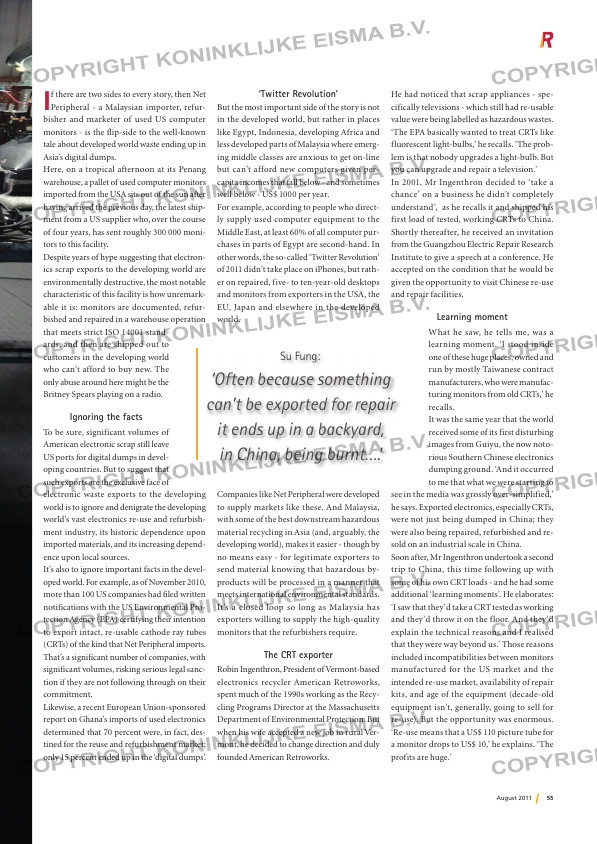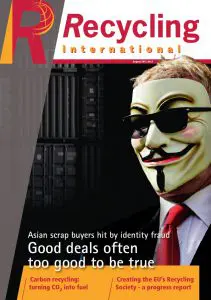Page 55 from: August 2011

55August 2011
If there are two sides to every story, then Net Peripheral – a Malaysian importer, refur-
bisher and marketer of used US computer
monitors – is the flip-side to the well-known
tale about developed world waste ending up in
Asia’s digital dumps.
Here, on a tropical afternoon at its Penang
warehouse, a pallet of used computer monitors
imported from the USA sits out of the sun after
having arrived the previous day, the latest ship-
ment from a US supplier who, over the course
of four years, has sent roughly 300 000 moni-
tors to this facility.
Despite years of hype suggesting that electron-
ics scrap exports to the developing world are
environmentally destructive, the most notable
characteristic of this facility is how unremark-
able it is: monitors are documented, refur-
bished and repaired in a warehouse operation
that meets strict ISO 14001 stand-
ards, and then are shipped out to
customers in the developing world
who can’t afford to buy new. The
only abuse around here might be the
Britney Spears playing on a radio.
Ignoring the facts
To be sure, significant volumes of
American electronic scrap still leave
US ports for digital dumps in devel-
oping countries. But to suggest that
such exports are the exclusive face of
electronic waste exports to the developing
world is to ignore and denigrate the developing
world’s vast electronics re-use and refurbish-
ment industry, its historic dependence upon
imported materials, and its increasing depend-
ence upon local sources.
It’s also to ignore important facts in the devel-
oped world. For example, as of November 2010,
more than 100 US companies had filed written
notifications with the US Environmental Pro-
tection Agency (EPA) certifying their intention
to export intact, re-usable cathode ray tubes
(CRTs) of the kind that Net Peripheral imports.
That’s a significant number of companies, with
significant volumes, risking serious legal sanc-
tion if they are not following through on their
commitment.
Likewise, a recent European Union-sponsored
report on Ghana’s imports of used electronics
determined that 70 percent were, in fact, des-
tined for the reuse and refurbishment market;
only 15 percent ended up in the ‘digital’dumps’.
‘Twitter Revolution’
But the most important side of the story is not
in the developed world, but rather in places
like Egypt, Indonesia, developing Africa and
less developed parts of Malaysia where emerg-
ing middle classes are anxious to get on-line
but can’t afford new computers given per-
capita incomes that fall below – and sometimes
well below – US$ 1000 per year.
For example, according to people who direct-
ly supply used computer equipment to the
Middle East, at least 60% of all computer pur-
chases in parts of Egypt are second-hand. In
other words, the so-called ‘Twitter Revolution’
of 2011 didn’t take place on iPhones, but rath-
er on repaired, five- to ten-year-old desktops
and monitors from exporters in the USA, the
EU, Japan and elsewhere in the developed
world.
Companies like Net Peripheral were developed
to supply markets like these. And Malaysia,
with some of the best downstream hazardous
material recycling in Asia (and, arguably, the
developing world), makes it easier – though by
no means easy – for legitimate exporters to
send material knowing that hazardous by-
products will be processed in a manner that
meets international environmental standards.
It’s a closed loop so long as Malaysia has
exporters willing to supply the high-quality
monitors that the refurbishers require.
The CRT exporter
Robin Ingenthron, President of Vermont-based
electronics recycler American Retroworks,
spent much of the 1990s working as the Recy-
cling Programs Director at the Massachusetts
Department of Environmental Protection. But
when his wife accepted a new job in rural Ver-
mont, he decided to change direction and duly
founded American Retroworks.
He had noticed that scrap appliances – spe-
cifically televisions – which still had re-usable
value were being labelled as hazardous wastes.
‘The EPA basically wanted to treat CRTs like
fluorescent light-bulbs,’ he recalls. ‘The prob-
lem is that nobody upgrades a light-bulb. But
you can upgrade and repair a television.’
In 2001, Mr Ingenthron decided to ‘take a
chance’ on a business he didn’t completely
understand’, as he recalls it and shipped his
first load of tested, working CRTs to China.
Shortly thereafter, he received an invitation
from the Guangzhou Electric Repair Research
Institute to give a speech at a conference. He
accepted on the condition that he would be
given the opportunity to visit Chinese re-use
and repair facilities.
Learning moment
What he saw, he tells me, was a
learning moment. ‘I stood inside
one of these huge places, owned and
run by mostly Taiwanese contract
manufacturers, who were manufac-
turing monitors from old CRTs,’ he
recalls.
It was the same year that the world
received some of its first disturbing
images from Guiyu, the now noto-
rious Southern Chinese electronics
dumping ground. ‘And it occurred
to me that what we were starting to
see in the media was grossly over-simplified,’
he says. Exported electronics, especially CRTs,
were not just being dumped in China; they
were also being repaired, refurbished and re-
sold on an industrial scale in China.
Soon after, Mr Ingenthron undertook a second
trip to China, this time following up with
some of his own CRT loads – and he had some
additional ‘learning moments’. He elaborates:
‘I saw that they’d take a CRT tested as working
and they’d throw it on the f loor. And they’d
explain the technical reasons and I realised
that they were way beyond us.’ Those reasons
included incompatibilities between monitors
manufactured for the US market and the
intended re-use market, availability of repair
kits, and age of the equipment (decade-old
equipment isn’t, generally, going to sell for
re-use). But the opportunity was enormous.
‘Re-use means that a US$ 110 picture tube for
a monitor drops to US$ 10,’ he explains. ‘The
profits are huge.’
Su Fung:
‘Often because something
can’t be exported for repair
it ends up in a backyard,
in China, being burnt….’
p054_E-scrap Malaysia.indd 55 08-08-11 15:34



